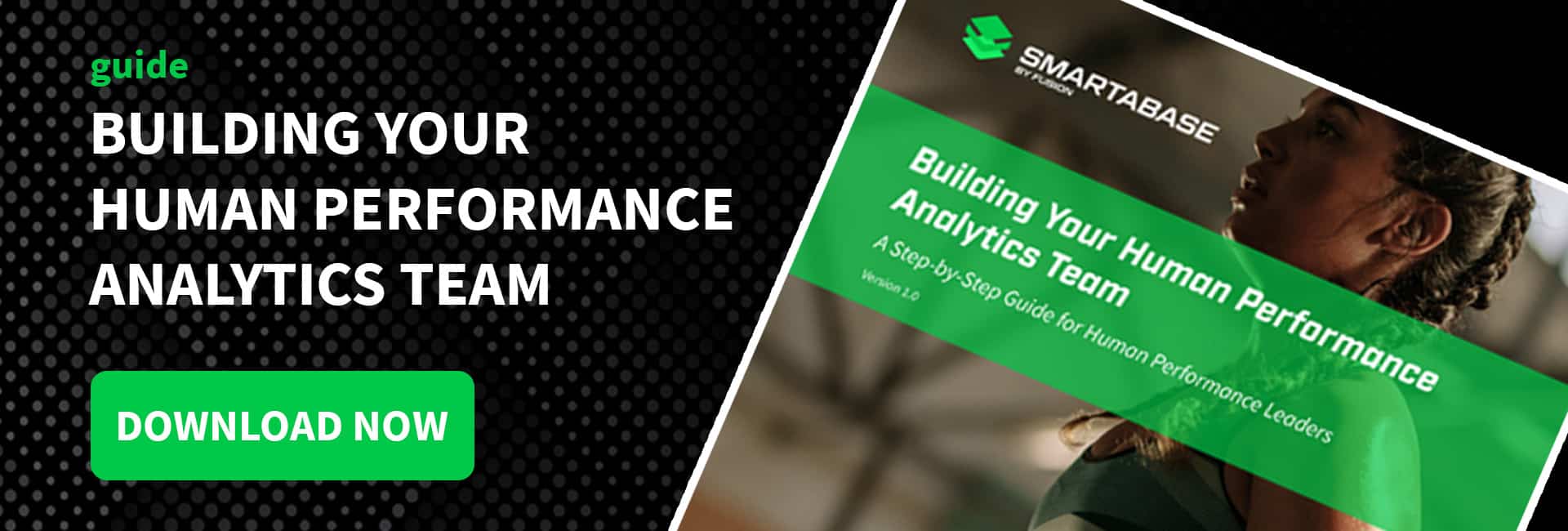As we explored in our recently released guide, Building Your Human Performance Analytics Team, there are several tried and true methods for structuring, staffing, and growing your human performance (HP) analytics group.
To give you a powerful real-world example, we reached out to Gus Kaeding, Senior Manager of Data and Analytics for US Ski & Snowboard. In addition to sharing his own career journey, he revealed the differences between hiring for small and large organizations, whether domain expertise or technical skills are more important, the benefits of generalists versus specialists, and more.
When Domain Expertise Matters
An ongoing debate in HP analytics is whether to prioritize hiring domain experts with a proven background in sports or the military, or technically proficient staff who could be skilled in math, statistics, and advanced techniques like machine learning.
“When you’re having that internal battle of whether to bring in someone who’s experienced in the sport or not, there are pluses and minuses to both sides,” Kaeding said. “If they’re not, they could still bring in fresh perspectives and things you haven’t thought of before, but you’re going to waste time bringing them up to speed on the intricacies of the sport. We also rely on passion to keep our projects moving forward because it’s not always a nine-to-five job and you need to work some nights and weekends. It’s harder to figure out who’s passionate if they haven’t spent time in the sport.”
Kaeding believes that for a smaller organization or one that’s just starting to build out a team, the former is a better fit because of the need to understand the discipline and how to best serve coaches and athletes alike. He’s living proof, having been a professional skier and coach before joining US Ski & Snowboard, which enabled him to establish data-informed baselines for its athletes. Then once the HP program is up and running with domain experts, more technically proficient staff can be added to augment initial hires’ skillsets. At this stage, they will also make better use of the data that’s already gathered in an athlete management system (AMS) like Smartabase, which Kaeding implemented at US Ski & Snowboard to unite information in a single platform.
“The approach we’ve used is building out a process conducted by subject matter experts who know what data to collect at first,” Kaeding said. “Then in that second wave of hiring where you still have your original team, you can bring in experts who aren’t as knowledgeable about your sport but can shake up the status quo. When you’re just starting with HP analytics, you’re designing a system to capture all the stats and deciding which few problems need to be solved. No one is going to need AI skills or advanced math and statistics to do it. That kind of thing comes later, once you have a more comprehensive data set.”
Hiring Generalists vs Specialists and Using Outside Resources
A professional team or well-funded Power 5 college athletic department might have the luxury of filling every HP analytics role – from director down to sports and data scientists, analysts, and so on – with specialists who have a narrowly defined list of responsibilities.
But for resource-constrained organizations, versatility is essential and at first, a single individual or small group might have to serve in a do-it-all capacity. This has been Kaeding’s experience at US Ski & Snowboard and showed him the advantages of being a generalist who’s willing to grow and acquire new skills. He’s been able to build on his background in business and math as his HP analytics career has progressed.
“Everything I’ve needed to learn, I’ve learned along the way,” Kaeding said. “As a sports scientist, I’m in an aiding role, and in a setup like ours where you have to be able to do a little bit of everything and I need to be a jack-of-all-trades, that’s okay.”
Another way that Kaeding maximizes his capacity is by reaching out to and leaning on colleagues in other roles. “Within this high-performance department, several of the athletic development coaches are particularly good with data,” he said. “They’re not only people I can collaborate with, but also ask for help. We work on projects together and they can lead their own, too, in terms of analysis.”
He also recognizes the value of consulting with companies like Fusion Sport, mentors interns, and receives assistance from third parties who want to assist with certain initiatives. “In almost every article I write for skiing magazines, I say that if anyone finds these problems interesting or wants to help, here’s my email address,” Kaeding said. “I get people who are eager to help every time, whether from academia or consultants who are good with data.”
Filtering and Prioritizing Projects
As an HP data team gets built out, its additional bandwidth can become as much of a curse as it is a blessing because there are endless requests from other departments and internal initiatives to scope, test, and execute. Data-related projects can originate with athletes, coaches, administrators, and almost any department within the organization. This can be even more problematic for a small HP analytics team, as there aren’t enough hours in the day to tackle all the incoming requests.
Kaeding shared that efficient time management is only possible when the HP analytics team’s focus remains on identifying who’s presenting an issue, if it’s worth solving, and how many people a solution would impact. This involves rigorous filtering to distinguish between essential and low-priority projects.
“I have a list of a gazillion things to do, and it requires constant prioritization: what is this problem-solving for and also, what scale is it?” Kaeding said. “If it’s just for one person, I’m less inclined to work on that. But if it’s something we can apply to all of our athletes and give an insight back to our community – where there’s scale to the 30,000 or 40,000 competitive athletes in the US – then that’s something I’m really interested in. What you spend your time on shows your priorities and can have a really big impact on the direction your data team ends up going.”
One way Kaeding zeroes in on high-value projects is by ensuring there’s continual communication between US Ski & Snowboard’s coaches, the broader performance staff, and his department. This way, these different areas aren’t siloed, there’s greater collaboration, and the HP analytics projects that get the green light often have a direct application to athlete training and development.
“When I speak to my counterparts in other sports, everyone has the same challenge with relating their findings and insights to what’s happening on the field and getting buy-in from the coaching staff,” Kaeding said. “I work very closely with our coaches, so I’ve been able to bridge that gap better than some. Most of the problems I’m solving are those that the coaches themselves have identified, which helps them to be more bought in. Sometimes, I use this as a Trojan horse and put in additional analysis I think would be helpful.”
The evolution of Kaeding’s role with US Ski & Snowboard is a powerful example of this problem-solving approach in action. “I knew the Nordic program director, Chris Grover, and asked him, ‘What’s a big problem you’re having?’” Kaeding said. He told me that team selection was based on coaches’ gut instinct, and he wanted it to become more objective. I started poring through the data to see who had done well historically and what it took to succeed at each level. We were able to create objective selection criteria for cross-country skiing, which is something we’ve now scaled to other teams.”
Justifying New Hires
The success of this project led to the expansion of Kaeding’s role and was a potent case study that demonstrated the validity of HP analytics to the US Ski & Snowboard leadership. Four years later, the organization continues to follow this highly targeted and specific method for applying data insights to athlete selection, development, and performance.
“Our cross-country ski team is very fit and strong compared to others, but it could be more efficient,” Kaeding explained. “We’ve purchased 3D motion capture cameras and will use the software to break down technique as athletes are using roller skis on treadmills. Instead of a coach just saying, ‘Your hips are too far back’ or ‘I think your hands are too high,’ we’ll actually know how to improve. We already use these types of practices in rehab, but this is our first foray into quantifying athletic movements with this kind of technology. It’s a big positive.”
Deploying this kind of technology and using the insights it provides to guide athlete preparation can lead to the creation of new roles, both for an HP analytics team and the human performance group in general.
“Now that we’re analyzing skiing movements rather than just dry land training, I’d imagine we’d hire a biomechanist, rather than us just having a consultant for this one project,” Kaeding said. “We’re looking at it as a proof of concept, and if it’s deemed to be valuable to our coaches and athletes, that’s the biggest single aid in going to leadership or donors and letting them know that this is a crucial piece we’re missing for all our teams. It shows the importance of working with the coaches throughout these projects because if they see the value, there will be more people on your side.”
Finding the Right People to Make Data Useful
Looking ahead, Kaeding sees the need for US Ski & Snowboard’s data analysis to become even more embedded with what coaches and performance staff are doing with athletes daily. “This next piece of our data department really needs to be in the field collecting information,” Kaeding said. “Currently, we try to do that with sensors, but when you don’t have someone on site, it can be difficult. In other high-level sports, they generally have an analyst whose job it is to collect all the data, go through it, and present it to the coaches or administration. This person would track everything that goes along with snow conditions, equipment, wax, and anything physiological or psychological for the athletes. Then when we’ve added this new data segment, we’ll need somebody to put it into a comprehensive system – including intake, organization, and storage – to make sure everything’s really useful.”
When it comes time to recruit for such roles, Kaeding will take technical proficiency, background, and experience into account. But he will also be searching for the kind of intangibles and enthusiasm that have enabled him to create a data-informed culture within US Ski & Snowboard that furthers the progress of everyone from Olympic medalists to promising junior athletes.
“Nobody’s skillset is ever going to translate 100 percent to whatever you’re doing,” Kaeding said. “You look for people who are willing to continually learn. One person might have all the software skills but not communicate information very well. Maybe someone else doesn’t know all the software but could learn it in just a few weeks. People in the data world are usually completely self-motivated because if it’s fun, then it’s easy.”
If You Enjoyed This Article, You Might Also Like…
- GUIDE: Building Your Human Performance Analytics Team
- Should You Outsource Your Human Performance Analytics Team?
- Using Archetypal Analysis for Team Training, Selection, and Cohesion
- Tips for Integrating Your Human Performance Platform with Analytics Tools
- Speaking X’s and O’s: How to Talk Data with Coaches









